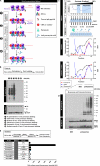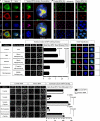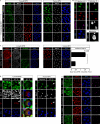Nuclear translation visualized by ribosome-bound nascent chain puromycylation
- PMID: 22472439
- PMCID: PMC3317795
- DOI: 10.1083/jcb.201112145
Nuclear translation visualized by ribosome-bound nascent chain puromycylation
Abstract
Whether protein translation occurs in the nucleus is contentious. To address this question, we developed the ribopuromycylation method (RPM), which visualizes translation in cells via standard immunofluorescence microscopy. The RPM is based on ribosome-catalyzed puromycylation of nascent chains immobilized on ribosomes by antibiotic chain elongation inhibitors followed by detection of puromycylated ribosome-bound nascent chains with a puromycin (PMY)-specific monoclonal antibody in fixed and permeabilized cells. The RPM correlates localized translation with myriad processes in cells and can be applied to any cell whose translation is sensitive to PMY. In this paper, we use the RPM to provide evidence for translation in the nucleoplasm and nucleolus, which is regulated by infectious and chemical stress.
Figures






Comment in
-
The enduring enigma of nuclear translation.J Cell Biol. 2012 Apr 2;197(1):7-9. doi: 10.1083/jcb.201202140. J Cell Biol. 2012. PMID: 22472436 Free PMC article.
Similar articles
-
Emetine optimally facilitates nascent chain puromycylation and potentiates the ribopuromycylation method (RPM) applied to inert cells.Histochem Cell Biol. 2013 Mar;139(3):501-4. doi: 10.1007/s00418-012-1063-8. Epub 2012 Dec 11. Histochem Cell Biol. 2013. PMID: 23229864 Free PMC article.
-
Applying the ribopuromycylation method to detect nuclear translation.Methods Mol Biol. 2015;1228:133-42. doi: 10.1007/978-1-4939-1680-1_11. Methods Mol Biol. 2015. PMID: 25311127
-
Ribopuromycylation in Coronavirus-Infected Cells.Methods Mol Biol. 2020;2203:231-238. doi: 10.1007/978-1-0716-0900-2_17. Methods Mol Biol. 2020. PMID: 32833216
-
Recent studies implicate the nucleolus as the major site of nuclear translation.Biochem Soc Trans. 2014 Aug;42(4):1224-8. doi: 10.1042/BST20140062. Biochem Soc Trans. 2014. PMID: 25110029 Review.
-
The moving parts of the nucleolus.Histochem Cell Biol. 2005 Mar;123(3):203-16. doi: 10.1007/s00418-005-0754-9. Epub 2005 Mar 2. Histochem Cell Biol. 2005. PMID: 15742198 Review.
Cited by
-
Nucleolin Aptamer N6L Reprograms the Translational Machinery and Acts Synergistically with mTORi to Inhibit Pancreatic Cancer Proliferation.Cancers (Basel). 2021 Oct 1;13(19):4957. doi: 10.3390/cancers13194957. Cancers (Basel). 2021. PMID: 34638443 Free PMC article.
-
Nuclear translation for immunosurveillance.Proc Natl Acad Sci U S A. 2013 Oct 29;110(44):17612-3. doi: 10.1073/pnas.1318259110. Epub 2013 Oct 18. Proc Natl Acad Sci U S A. 2013. PMID: 24143809 Free PMC article. No abstract available.
-
Identification of embryonic RNA granules that act as sites of mRNA translation after changing their physical properties.iScience. 2022 May 5;25(6):104344. doi: 10.1016/j.isci.2022.104344. eCollection 2022 Jun 17. iScience. 2022. PMID: 35620421 Free PMC article.
-
A Fluorescence in Situ Hybridization Method To Quantify mRNA Translation by Visualizing Ribosome-mRNA Interactions in Single Cells.ACS Cent Sci. 2017 May 24;3(5):425-433. doi: 10.1021/acscentsci.7b00048. Epub 2017 May 3. ACS Cent Sci. 2017. PMID: 28573204 Free PMC article.
-
Local translation in nuclear condensate amyloid bodies.Proc Natl Acad Sci U S A. 2021 Feb 16;118(7):e2014457118. doi: 10.1073/pnas.2014457118. Proc Natl Acad Sci U S A. 2021. PMID: 33568529 Free PMC article.
References
-
- Apcher S., Daskalogianni C., Lejeune F., Manoury B., Imhoos G., Heslop L., Fåhraeus R. 2011. Major source of antigenic peptides for the MHC class I pathway is produced during the pioneer round of mRNA translation. Proc. Natl. Acad. Sci. USA. 108:11572–11577 10.1073/pnas.1104104108 - DOI - PMC - PubMed
Publication types
MeSH terms
Substances
Grants and funding
LinkOut - more resources
Full Text Sources
Other Literature Sources

